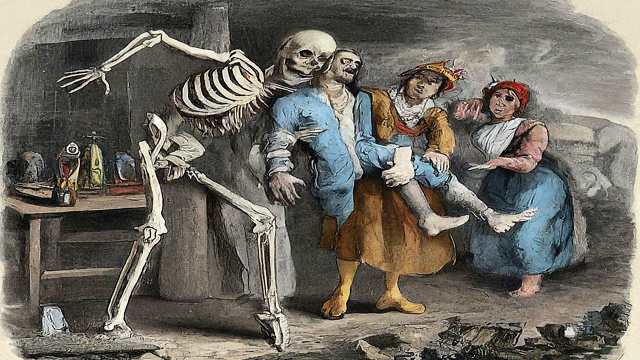In the early 19th century, a unique and idiosyncratic interpretation of the Danse Macabre emerged through the collaboration of writer William Combe and artist Thomas Rowlandson. Their work, The English Dance of Death (1815-16), presents a vivid and satirical portrayal of mortality, blending humor with social commentary in a distinctly English context.
This piece stands out not only for its artistic merit but also for its reflection of the societal attitudes of the time.
The Life of William Combe
William Combe was born in 1741, under circumstances that remain somewhat ambiguous. Educated at Eton and Oxford, he failed to complete his degree, but in 1762, he received a substantial bequest of £2,000 from a London Alderman, who may have been his father. Unfortunately, Combe squandered this fortune quickly, leading a life marked by financial instability. He took on various roles, including soldier, cook, and waiter, before settling in London as a hack writer.
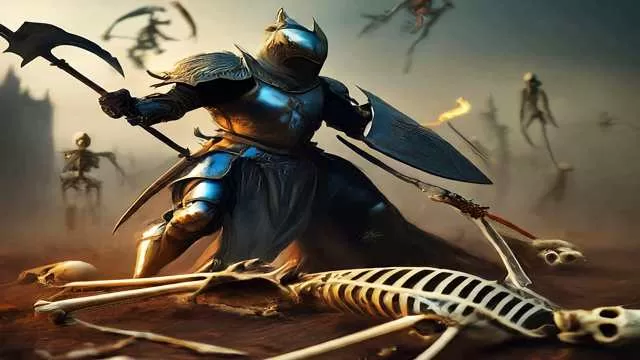
During this period, Combe published several works, including The Diaboliad and The Diabo-Lady, which were sharp political satires that gained popularity. He also wrote political propaganda for the Pitt government and edited works by other authors. However, much of his later life was spent in the King’s Bench Prison, a debtor’s prison in Southwark, where he continued to write.
Collaboration with Thomas Rowlandson
Combe’s partnership with Thomas Rowlandson, a talented artist known for his satirical illustrations, led to the creation of The Tour of Doctor Syntax in Search of the Picturesque (1812). This work was so successful that it spawned two sequels, In Search of Consolation and In Search of a Wife, which were later published together. Rowlandson, who was slightly younger than Combe, also faced financial difficulties and was known for his extravagant lifestyle, often spending long hours at gaming tables.
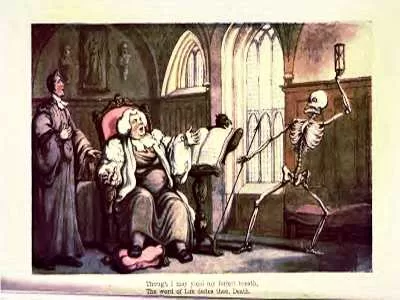
In 1815-16, Ackermann published The English Dance of Death, which featured Rowlandson’s engravings alongside Combe’s verses. This work reimagined the traditional Dance of Death motif, placing the skeletal figure of Death in various English social settings. Unlike Hans Holbein’s earlier depictions, which carried strong religious overtones, Combe and Rowlandson’s version embraced a more secular and humorous approach, reflecting the social dynamics of early 19th-century England.
A Satirical Take on Society
The cycle begins with a dialogue between Death and Time, setting the stage for a series of vignettes that explore mortality through a distinctly English lens. The characters depicted are not merely victims of death; they are part of a larger community, portrayed with a mix of humor and poignancy. For instance, the Old Woman is depicted as a scrawny shrew, dragged out into the night by her husband, contrasting sharply with Holbein’s more sympathetic portrayal of the elderly.
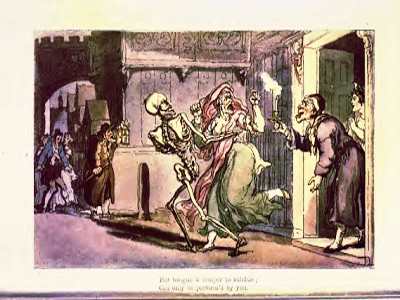
One of the most memorable illustrations features the Apothecary, represented as a quack doctor hawking dubious potions to a line of patients. Combe’s verse humorously critiques the medical profession, highlighting the absurdity of the situation:
“See how his Visage he disposes,
As his hands measure out the doses;
While his round paunch most truly tells,
He never takes the Drugs he sells.”
The work also includes a depiction of the Drunkard, who is carried away in a wheelbarrow, surrounded by his boisterous companions. This scene captures the revelry of the English tavern culture while simultaneously commenting on the consequences of excess:
“Some die with hemp around their gullets,
And some from balls and some from bullets:
But ‘Twas the fate of poor JACK MARROW,
To breathe his last on a Wheel-barrow.”
Poignant Moments Amidst the Humor
While much of The English Dance of Death is characterized by its humor, there are also deeply poignant moments that reflect the harsh realities of life and death. One such illustration features a soldier, a raw recruit marching off to war, oblivious to the fact that the recruiting sergeant is, in fact, Death. The soldier dreams of glory, leaving behind his love with a tender kiss, while she knows the grim truth:
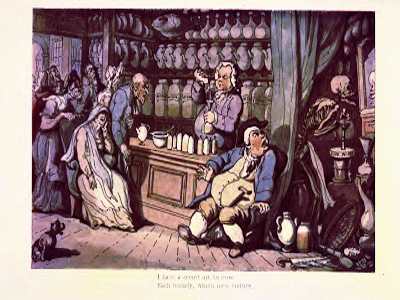
“The Sexton says he knows you well,
And ’tis an idle tale you tell:
That your recruits are always slain,
And never see their homes again.”
Another heart-wrenching scene depicts a child in its cradle, taken by Death while its drunken wet-nurse sleeps nearby. The mother returns to find her child dead, a stark reminder of the fragility of life:
“Death rocks the Cradle, as you see,
And sings his mortal Lullaby.
No shrieks, no cries will now its slumbers break;
The Infant sleeps, ah, never to awake!”
Legacy of The English Dance of Death
The English Dance of Death is a remarkable work that captures the essence of early 19th-century English society. It is a blend of humor, satire, and poignant reflection on mortality, showcasing the talents of both Combe and Rowlandson. The work’s ability to balance lightheartedness with serious themes makes it a unique contribution to the genre of macabre art.
In conclusion, Combe and Rowlandson’s collaboration offers a fresh perspective on the Dance of Death motif, transforming it into a commentary on the human condition. Their work remains relevant today, reminding us of the inevitability of death while encouraging us to embrace life with humor and resilience. As we navigate our own lives, The English Dance of Death serves as a reminder that while death is a certainty, the way we approach it can be filled with wit, wisdom, and a touch of English eccentricity.

